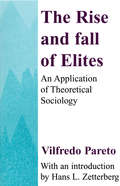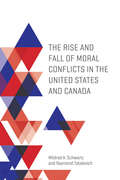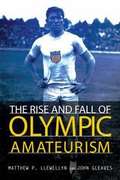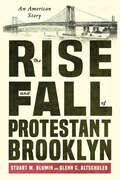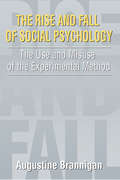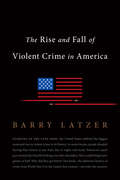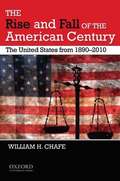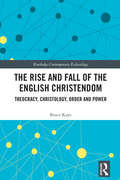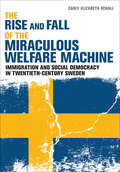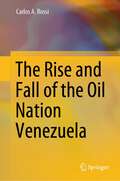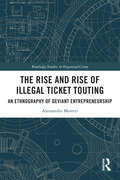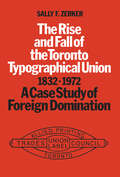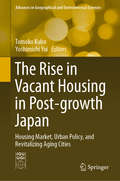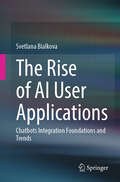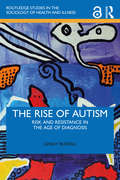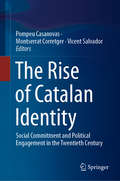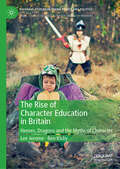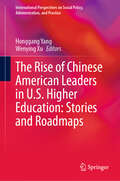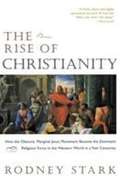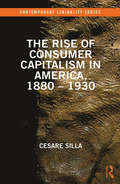- Table View
- List View
The Rise and Fall of Elites: Application of Theoretical Sociology (Perennial Works In Sociology)
by Everett Lee HuntCombining a thorough introduction to the work of nineteenth-and early twentieth-century Italian social theorist Vilfredo Pareto with a highly readable English translation of Pareto's last monograph "Generalizations," originally published in 1920, this work illustrates how and why democratic forms of government undergo decay and are eventually reinvigorated. More than any other social scientist of his generation, Pareto offers a well-developed, articulate, and compelling theory of change based on a Newtonian vision of science and an engineering model of social equilibrium. This dynamic involves a shifting balance among the countervailing forces of centralization and decentralization of power, economic expansion and contraction, and liberalism versus traditionalism in public sentiment. By 1920, Pareto had developed a scheme for predicting shifts in magnitude of these forces and subsequent change in the character of society. This book will be of interest to students, teachers, or general readers interested in political science, sociology and late-nineteenth/ early-twentieth century social theory.
The Rise and Fall of Moral Conflicts in the United States and Canada
by Mildred A. Schwartz Raymond TatalovichIn The Rise and Fall of Moral Conflicts in the United States and Canada, sociologist Mildred A. Schwartz and political scientist Raymond Tatalovich bring their disciplinary insights to the study of moral issues. Beginning with prohibition, Schwartz and Tatalovich trace the phases of its evolution from emergence, establishment, decline and resurgence, to resolution. Prohibition’s life history generates a series of hypotheses about how passage through each of the phases affected subsequent developments and how these were shaped by the political institutions and social character of the United States and Canada. Using the history of prohibition in North America as a point of reference, the authors move on to address the anticipated progression and possible resolution of six contemporary moral issues: abortion, capital punishment, gun control, marijuana, pornography, and same-sex relations. Schwartz and Tatalovich build a new theoretical approach by drawing on scholarship on agenda-setting, mass media, social movements, and social problems. The Rise and Fall of Moral Conflicts provides new insights into how moral conflicts develop and interact with their social and political environment.
The Rise and Fall of Olympic Amateurism
by John Gleaves Matthew P LlewellynFor decades, amateurism defined the ideals undergirding the Olympic movement. No more. Today's Games present athletes who enjoy open corporate sponsorship and unabashedly compete for lucrative commercial endorsements. Matthew P. Llewellyn and John Gleaves analyze how this astonishing transformation took place. Drawing on Olympic archives and a wealth of research across media, the authors examine how an elite--white, wealthy, often Anglo-Saxon--controlled and shaped an enormously powerful myth of amateurism. The myth assumed an air of naturalness that made it seem unassailable and, not incidentally, served those in power. Llewellyn and Gleaves trace professionalism's inroads into the Olympics from tragic figures like Jim Thorpe through the shamateur era of under-the-table cash and state-supported athletes. As they show, the increasing acceptability of professionals went hand-in-hand with the Games becoming a for-profit international spectacle. Yet the myth of amateurism's purity remained a potent force, influencing how people around the globe imagined and understood sport. Timely and vivid with details, The Rise and Fall of Olympic Amateurism is the first book-length examination of the movement's foundational ideal.
The Rise and Fall of Protestant Brooklyn: An American Story
by Glenn C. Altschuler Stuart M. BluminIn The Rise and Fall of Protestant Brooklyn, Stuart M. Blumin and Glenn C. Altschuler tell the story of nineteenth-century Brooklyn's domination by upper- and middle-class Protestants with roots in Puritan New England. This lively history describes the unraveling of the control they wielded as more ethnically diverse groups moved into the "City of Churches" during the twentieth century.Before it became a prime American example of urban ethnic diversity, Brooklyn was a lovely and salubrious "town across the river" from Manhattan, celebrated for its churches and upright suburban living. But challenges to this way of life issued from the sheer growth of the city, from new secular institutions—department stores, theaters, professional baseball—and from the licit and illicit attractions of Coney Island, all of which were at odds with post-Puritan piety and behavior. Despite these developments, the Yankee-Protestant hegemony largely held until the massive influx of Southern and Eastern European immigrants in the twentieth century. As The Rise and Fall of Protestant Brooklyn demonstrates, in their churches, synagogues, and other communal institutions, and on their neighborhood streets, the new Brooklynites established the ethnic mosaic that laid the groundwork for the theory of cultural pluralism, giving it a central place within the American Creed.
The Rise and Fall of Social Psychology: An Iconoclast's Guide to the Use and Misuse of the Experimental Method (Social Problems And Social Issues Ser.)
by Augustine BranniganThis unflinching effort critically traces the attempt of social psychology over the past half century to forge a scientific understanding of human behavior based on the systematic use of experiments.Having examined the record from the inception of the field to the present, Brannigan suggests that it has failed to live up to its promise: that social psychologists have achieved little consensus about the central problems in the field; that they have failed to amass a body of systematic, non-trivial theoretical insight; and that recent concerns over the ethical treatment of human subjects could arguably bring the discipline to closure. But that is not the disastrous outcome that Brannigan hopes for. Rather, going beyond an apparent iconoclasm, the author explores prospects for a post-experimental discipline. It is a view that admits the role of ethical considerations as part of scientific judgment, but not as a sacrifice of, but an extension of, empirical research that takes seriously how the brain represents information, and how these mechanisms explain social behaviors and channel human choices and appetites.What makes this work special is its function as a primary text in the history as well as the current status of social psychology as a field of behavioral science. The keen insight, touched by the gently critical styles, of such major figures as Philip Zimbardo, Morton Hunt, Leon Festinger, Stanley Milgram, Alex Crey, Samuel Wineburg, Carol Gilligan, David M. Buss--among others--makes this a perfect volume for students entering the field, and no less, a reminder of the past as well as present of social psychology for its serious practitioners.
The Rise and Fall of Violent Crime in America
by Barry LatzerStarting in the late 1960s, the United States suffered the biggest rise in violent crime in its history. Aside from the movement for black civil rights, it is difficult to think of a phenomenon that had a more profound effect on American life in the last third of the 20th century. Fear of murder, rape, robbery and assault influenced decisions on where to live and where to school one's children, how to commute to work and where to spend one's leisure time. In some locales, people dreaded leaving their homes at any time, day or night, and many Americans spent part of each day literally looking over their shoulders.The Rise and Fall of Violent Crime in America is a landmark synthesis of criminology and social history that fully explains how and why violent crime exploded across the United States in the late 60s-and what ultimately drove it down decades later. It is the first book of its kind to analyze criminal violence in the U.S. from World War II to the 21st century. It examines crime in the context of all of the major social trends since the World War, including the postwar economic boom and suburbanization, the baby boom and the turmoil of the 60s, the urbanization of minorities, the advent of crack cocaine, the hardening of the criminal justice system and current efforts to contract it. Latzer's sweeping, definitive study at last brings coherence to the bewildering array of explanations for the nightmarish reality that many Americans lived with for decades.
The Rise and Fall of an Urban Sexual Community
by Dana CollinsThis book examines how gay place-making challenged the juggernaut of neoliberal urbanization in the Malate district of Manila. In this ethnography, Collins explores the creation of place, characterized by neighborhood renewal, gay community and entrepreneurialism, and informal gay sexual labor. Malate teaches us that the power of sexual community to sustain a transgressive, inclusive, gay neighborhood is circumscribed and fleeting, and that urban livability, justice, and freedom must be pursued through organized grassroots political projects if the magic of Malate is to be revived for all its residents.
The Rise and Fall of the American Century: The United States from 1890-2009
by William H. ChafeFrom William H. Chafe, the best-selling author of The Unfinished Journey, comes a new text that offers in-depth and enlightening coverage of the history of the United States in the twentieth century. The Rise and Fall of the American Century: The United States from 1890-2010 describes the rise- and potential fall - of the U. S. , a nation more powerful, more wealthy, and more dominant than any in human history. It also acknowledges the persistent challenges the U. S. has faced and continues to face - inequalities of race, gender, and income that contradict its vision of itself as "a land ofopportunity. "Examining the evolution of the United States since 1890, The Rise and Fall of the American Century chronicles the varying mood of the country through its changing presidencies, from the rise of the metropolis and Teddy Roosevelt in the 1890s to the turbulent era of the Bush administration at thebeginning of the twenty-first century. By analyzing the shifting moods and social and political upheavals (both at home and abroad) and the United States's reactions to these events, the book seeks to understand how the country both achieved its vision for itself in some ways but failed to realizeit in others. Working in a political framework, Chafe also provides a strong balance of social and cultural history, touching on the African-American, Latino, and Asian communities, the West, and the changing status of women. The book's epilogue discusses important economic and political eventsthrough 2008, including the financial crisis and the 2008 Presidential Election.
The Rise and Fall of the American Teenager
by Thomas HineThis book is a glorious appreciation of youth and illuminates the fascinating history of teenagers and how we have transformed our view of them in our society.
The Rise and Fall of the English Christendom: Theocracy, Christology, Order and Power (Routledge Contemporary Ecclesiology)
by Bruce KayeEnglish Christendom has never been a static entity. Evangelism, politics, conflict and cultural changes have constantly and consistently developed it into myriad forms across the world. However, in recent times that development has seemingly become a general decline. This book utilises the motif of Christendom to illuminate the pedigree of Anglican Christianity, allowing a vital and persistent dynamic in Christianity, namely the relationship between the sacred and the mundane, to be more fundamentally explored. Each chapter seeks to unpack a particular historical moment in which the relations of sacred and mundane are on display. Beginning with the work of Bede, before focusing on the Anglo Norman settlement of England, the Tudor period, and the establishment of the church in the American and Australian colonies, Anglicanism is shown to consistently be a religio-political tradition. This approach opens up a different set of categories for the study of contemporary Anglicanism and its debates about the notion of the church. It also opens up fresh ways of looking at religious conflict in the modern world and within Christianity. This is a fresh exploration of a major facet of Western religious culture. As such, it will be of significant interest to scholars working in Religious History and Anglican Studies, as well as theologians with an interest in Western Ecclesiology.
The Rise and Fall of the Miraculous Welfare Machine: Immigration and Social Democracy in Twentieth-Century Sweden
by Carly Elizabeth SchallSweden is well known for the success of its welfare state. Many believe that success was made possible in part by the country's ethnic homogeneity and that the increased diversity of Sweden’s population is putting its welfare state at risk. Few, however, have suggested convincing mechanisms for explaining the precise relationship between relative ethnic homogeneity/heterogeneity and the welfare state. In this book Carly Elizabeth Schall acknowledges the important role of ethnic homogeneity in Sweden’s thriving welfare state, but she argues that it mattered primarily because political elites—especially social democrats—made it matter. Schall shows that diversity and the welfare state are related but that diversity does not undermine the welfare state in a straightforward way. Tracing the development of the Swedish welfare state from the late 1920s until the present day, she focuses on five historical periods of crisis. She argues that the story of Swedish national identity is a story of elite-driven hegemony-building and that the linking of social democracy and national identity colored the integration of immigrants in important ways. Social democracy could have withstood the challenge posed by immigration, but the faltering of social democratic hegemony opened a door for anti-immigrant sentiment. In her deft analysis of the relationship between immigration and the welfare state in Sweden, Schall makes a compelling argument that has relevance for immigration policy in the United States and elsewhere.
The Rise and Fall of the Oil Nation Venezuela
by Carlos A. RossiThis book explains why Venezuela is so rich in natural resources—it has been producing oil since 1922 and harbors the largest oil reserves in the world—and yet it is also a failed nation of class-divided citizens exhibiting deep poverty in a corrupt, incompetent state. Venezuela is a bipolar nation, where two marked poles in the society exist which have historical origins and are mutually exclusive.The book provides a critical analysis of Venezuela's history, economy and politics and explains the context and implications of the bipolar poles, known as the elite pole and the resentful pole. Both, it shows, have done serious harm to Venezuela’s prosperity.The author describes the vicious circle of oil wealth, corruption, inefficiency and world market dependency and gives recommendations for a better future.
The Rise and Rise of Illegal Ticket Touting: An Ethnography of Deviant Entrepreneurship (Routledge Studies in Organised Crime)
by Alessandro MorettiThis book presents an ethnographic study of contemporary ticket touts in the UK. Despite the recent interest in the topic of black-market ticket sales, media coverage and parliamentary interventions over the last ten years have revealed a widespread lack of knowledge with regards to the phenomenon of touting and the players involved in the practice. The Rise and Rise of Illegal Ticket Touting sheds light on the world of touting and delivers an authentic picture of the individuals involved, of their methods, values, and motivations for performing ticket touting as an organised, entrepreneurial deviant activity. The touts’ attitudes, perceptions, adaptations to – or outright dismissal of – the changing legal landscape are focal points of the study. Of equal importance are the touts’ varied methods of buying and selling tickets, the hierarchical structures and strict ethos of their criminal organisations, and their specific modi operandi for evading detection and arrest both on the streets and online. This book illuminates why historic and renewed attempts to challenge ticket touting have been unsuccessful, focusing on inadequate legislation, a lack of enforcement, and the widespread corruption and exploitable loopholes that exist within the official, primary ticket market. An accessible and compelling read, The Rise and Rise of Illegal Ticket Touting will appeal to students and scholars of criminology, sociology, social policy, policing and all those with an interest in live music and sport and the hidden practices that lurk beneath the surface.
The Rise and Size of the Fitness Industry in Europe: Fit for the Future?
by Jeroen Scheerder Hanna Vehmas Kobe HelsenThis book explores the rise, size and shape of the European fitness industry by using harmonised data as well as in-depth analyses of national surveys in fifteen European countries. Following an introduction to the socio-historical and conceptual aspects of fitness, the collection presents the scope of fitness as a business and participatory activity. Furthermore, both policy and governance issues as well as community and supply angles are considered. Drawing on this unique material, the book will appeal to students and scholars of sport business, sport economics, sport management, and social sport sciences, but also to administrators, policymakers and entrepreneurs in the international and national sport and health community.
The Rise and fall of the Toronto Typographical Union
by Sally F. ZerkerA meeting of twenty-four journeymen printers at the York Hotel in Toronto in 1832 marked the birth of Canada's earliest and still continuing labour organization. This case study of the printers of Toronto traces the development of the union which began as the Toronto Typographical Society. Through a close examination of this Canadian local's relations with its eventual parent organization in the US, Zerker reveals the 'domination' and brings into question the advantages of an international connection.In 1866, under pressure from the American federation of printing unions, the Toronto body became an affiliate of the International Typographical Union, thus forming the crucial relationship which, as Zerker shows, came to govern every element of local decision and policy. Though the TTU achieved a pioneer victory in independently leading its members in their struggle for a shorter working day, from 1885 on the ITU directives and programs came to rule the Toronto union, causing enormous losses in membership and industry control.Zerker cites as examples the ITU program in the 1920s which resulted in a bitter strike which broke the Toronto union's control of the labour force in the commercial sector; and, more recently, its misdirection of the printers' strike of the Toronto newspapers in the 1960s which resulted in the expulsion of members from the workplaces that had been the preserve of the organization for nearly a century. Zerker blames the failure to respond effectively to the technology of the computer age on poor TTU management in pre-strike negotiations but, above all, on ITU intransigence, ignorance, and arrogance. In more recent years, after the end of this history, TTU membership has increased substantially and the local has been revitalized under its new leadership; the International, too, shows signs of being on the way to much-awaited reforms.This history is in many senses a microcosm of the Canadian labour movement and forms an important strand in general cultural history of Toronto.
The Rise in Vacant Housing in Post-growth Japan: Housing Market, Urban Policy, and Revitalizing Aging Cities (Advances in Geographical and Environmental Sciences)
by Tomoko Kubo Yoshimichi YuiThis book explores how Japanese cities have transformed since the 1950s by describing housing and urban planning policies, urbanization processes, and maps with GIS analysis. It also discusses how housing vacancies have increased in shrinking Japanese cities, with case studies in Tokyo, Kyoto, Hiroshima, and Utsunomiya, and examines public–private partnerships and civil engagement to revitalize cities. Providing examples of how Japanese cities have addressed the issues of aging populations and urban shrinkage, it contributes to better decision-making by politicians, planners, local authorities, NPOs, and local communities in many rapidly urbanizing and potentially aging regions such as Asia.In the era of urban shrinkage, Japanese cities have struggled with aging populations, low fertility, population loss, and a decline in the economic base over decades. In particular, shrinkage in metropolitan suburbs and large cities (e.g., sites of prefectural government with 300 000–400 000 inhabitants) has caused serious social problems owing to the huge aging population and large areas covered. One typical problem that has emerged is an increase in vacancies in now empty and abandoned housing.
The Rise of AI User Applications: Chatbots Integration Foundations and Trends
by Svetlana BialkovaThis monograph introduces readers to core theories and applications in the chatbot AI context. Although AI is attracting significant attention, there is a literature gap and lack of practical guidelines on the key drivers of chatbot efficiency and agency capacity. There is a caveat between algorithmic explanations and actionable understanding, despite the acknowledged importance of inherently human-centric properties. Addressing these gaps, this state-of-the-art book offers a distinctive combination of content, theory, practice evaluation, and a holistic framework encompassing cognitive, emotional and social aspects, focusing on how to enhance AI agency and user experience. The framework aims to drive design, encouraging development of intelligent systems, techniques to evaluate chatbot with purposes, to appropriately meet user needs and market demand for responsible and explainable AI, XAI. Avenues for transforming business and life by implementing new generation AI systems are further discussed, as well as recommendations to overcome consumer resistance and advice for policy measures to reduce risks given the AI boost. While the community is still in an exploratory mode, we hope “The Rise of AI User Applications: Chatbots Integration Foundations and Trends” provides the needed understanding and will inspire researchers across disciplines to combine their efforts and work together on this very intriguing topic.
The Rise of Autism: Risk and Resistance in the Age of Diagnosis
by Ginny RussellThis innovative book addresses the question of why increasing numbers of people are being diagnosed with autism since the 1990s. Providing an engaging account of competing and widely debated explanations, it investigates how these have led to differing interpretations of the same data. Crucially, the author argues that the increased use of autism diagnosis is due to medicalisation across the life course, whilst holding open the possibility that the rise may also be partly accounted for by modern-day environmental exposures, again, across the life course. A further focus of the book is not on whether autism itself is valid as a diagnostic category, but whether and how it is useful as a diagnostic category, and how the utility of the diagnosis has contributed to the rise. This serves to move beyond the question of whether diagnoses are 'real' or social constructions, and instead asks: who do diagnoses serve to benefit, and at what cost do they come? The book will appeal to clinicians and health professionals, as well as medical researchers, who are interested in a review of the data which demonstrates the rising use of autism as a diagnosis, and an analysis of the reasons why this has occurred. Providing theory through which to interpret the expanding application of the diagnosis and the broadening of autism as a concept, it will also be of interest to scholars and students of sociology, philosophy, psychiatry, psychology, social work, disability studies and childhood studies.
The Rise of Autonomous Smart Cities: Technology, Economic Performance and Climate Resilience (Sustainable Urban Futures)
by Zaheer AllamThis book introduces the concept of the ‘autonomous city’- a concept that has been developed from the ‘smart cities’ model that is based on a city’s ability to gather data and taking it one step further. The digital revolution has brought about numerous changes in the urban realm, along with the understanding that technology can aid in increasing the performance and efficiency of urban areas. This technology has given rise to a wealth of data allowing urban leaders to respond better to crisis and craft policies that increase the liveability of urban areas. The ‘autonomous city’ explores the possibility of urban areas evolving from the dimension of data gathering to that of action response – so a city able to collect data and render real time decisions to self-manage a variety of functions based on its interpretation of that data. The book discusses how this could lead to the automation of select urban dimensions for increased efficiency and performance, but also details how such a process would require careful consideration when put into practice. This book will be a valuable resource for scholars and students across Urban Planning, Sustainability and STS, as well as practitioners and policy makers involved in the development of urban life.
The Rise of Catalan Identity: Social Commitment and Political Engagement in the Twentieth Century
by Pompeu Casanovas Montserrat Corretger Vicent SalvadorThis volume helps us to understand that the current political disorders in Catalonia have deep cultural roots. It focuses on the rise of Catalan cultural, national and linguistic identity in the 20th century. What is happening in Catalonia? What lies behind its political conflicts? Catalan identity has been evolving for centuries, starting in early medieval ages (11th and 12lve centuries). It is not a modern phenomenon. The emergence of imperial Spain in the 16 c. and the French Ancien Régime in the 17 c. correlates with a decline of Catalan culture, which was politically absorbed by the Spanish state after the conquest of Barcelona in 1714. However, Catalan language and culture flourished again under the stimulus of the European Romantic Nationalism movement (known as the Renaixença in Catalonia). During the first Dictatorship (Primo de Rivera, 1923-1930), the Spanish Civil War (1936-1939), and the long Francoist era (1939-1975), Catalan language and culture were repressed, yet refurbished and reconstructed at the same time. This rise of a plural, complex, and non-homogeneous Catalan identity constitutes the subject matter of this volume. National conflicts that emerged later in the Spanish democratic state leant heavily on the life engagement and vital commitment experienced by the entrenched intellectual movements of the twentieth century in Catalonia, Valencian Country and the Balearic Islands. This book reveals the cultural and literary grassroots of these conflicts.
The Rise of Character Education in Britain: Heroes, Dragons and the Myths of Character (Palgrave Studies in Young People and Politics)
by Lee Jerome Ben KisbyWhat is character education? Why has it risen up the political agenda in the UK in recent years? And what does it mean in pedagogical practice? This book addresses these questions, challenging the individualistic and moralistic ideas underlying the clamour amongst politicians, educators and authors to promote ‘grit’, ‘resilience’ and ‘character’ in schools. Closely examining a range of teaching resources, the book shows that the development of character is wrongly presented as the solution to a wide variety of social problems, with individual citizens expected to accommodate themselves to the realities of the contemporary economic context, rather than enhancing their capacities to engage in civic and political activities to bring about changes they wish to see. The book argues that there is a tried and tested alternative to character education, which is far more likely to strengthen British democracy, namely, citizenship education.
The Rise of Chicago's Black Metropolis, 1920-1929
by Christopher Robert ReedDuring the Roaring '20s, African Americans rapidly transformed their Chicago into a "black metropolis." In this book, Christopher Robert Reed describes the rise of African Americans in Chicago's political economy, bringing to life the fleeting vibrancy of this dynamic period of racial consciousness and solidarity. Reed shows how African Americans rapidly transformed Chicago and achieved political and economic recognition by building on the massive population growth after the Great Migration from the South, the entry of a significant working class into the city's industrial work force, and the proliferation of black churches. Mapping out the labor issues and the struggle for control of black politics and black business, Reed offers an unromanticized view of the entrepreneurial efforts of black migrants, reassessing previous accounts such as St. Clair Drake and Horace R. Cayton's 1945 study Black Metropolis. Utilizing a wide range of historical data, The Rise of Chicago's Black Metropolis, 1920-1929 delineates a web of dynamic social forces to shed light on black businesses and the establishment of a black professional class. The exquisitely researched volume draws on fictional and nonfictional accounts of the era, black community guides, mainstream and community newspapers, contemporary scholars and activists, and personal interviews.
The Rise of Chinese American Leaders in U.S. Higher Education: Stories and Roadmaps (International Perspectives on Social Policy, Administration, and Practice)
by Wenying Xu Honggang YangThis book is a collection of stories and reflections that represent Chinese American leaders and depict their tortuous journeys in U.S. higher education that comes at a critical point in time. Many books have been devoted to academic leadership, but this volume uniquely focuses on subjects most relevant to Chinese Americans. We live at a time that not only witnesses an increase in Chinese American leaders on U.S. campuses but also mounting incidents of discriminatory treatment of this group. This book showcases 36 stories and reflections from past, present, and future leaders, including the five previously published stories. They represent leaders holding different ideological values in various academic fields, positions, stages of careers, professional trajectories, generations, Chinese ethnic groups, and geographical locations. The Rise of Chinese American Leaders in U.S. Higher Education makes a valuable contribution to the body of literature that has assisted countless academic leaders in navigating their careers, bringing to the forefront a distinct group of academic leaders who have been underrepresented.
The Rise of Christianity: How the Obscure, Marginal Jesus Movement Became the Dominant Religious Force in the Western World in a Few Centuries
by Rodney StarkSociologist Rodney Stark combines his expertise in social science with historical evidence to offer a provocative report. Stark finds that early Christianity attracted the privileged rather than the poor, and that Christianity's astounding dominance of the Western world arose from its offer of a better, more secure way of life.
The Rise of Consumer Capitalism in America, 1880 - 1930 (Contemporary Liminality)
by Cesare SillaThis book offers a genealogical account of the rise of consumer capitalism, tracing its origins in America between 1880 and 1930 and explaining how it emerged to become the dominant form of social organization of our time. Asking how it was that we came to be consumers who live in societies that revolve around an ever-spinning circle of production and consumption, not only of goods, but also of events, experiences, emotions and relations, The Rise of Consumer Capitalism in America presents an extensive analysis of primary sources to demonstrate the conditions and forces from which consumer capitalism emerged and became victorious. Employing a Weberian approach that brings liminality to the fore as a master concept to make sense of historical change, the author links an in-depth empirical investigation to supple sociological theorizing to show how the encirclement of all aspects of life by the logic of consumer capitalism was a time-bound historical creation rather than a necessary one. A fascinating study of the appearance and triumph of the "ideology" of our age, this book will appeal to scholars of social and anthropological theory, historical sociology, cultural history and American studies.
